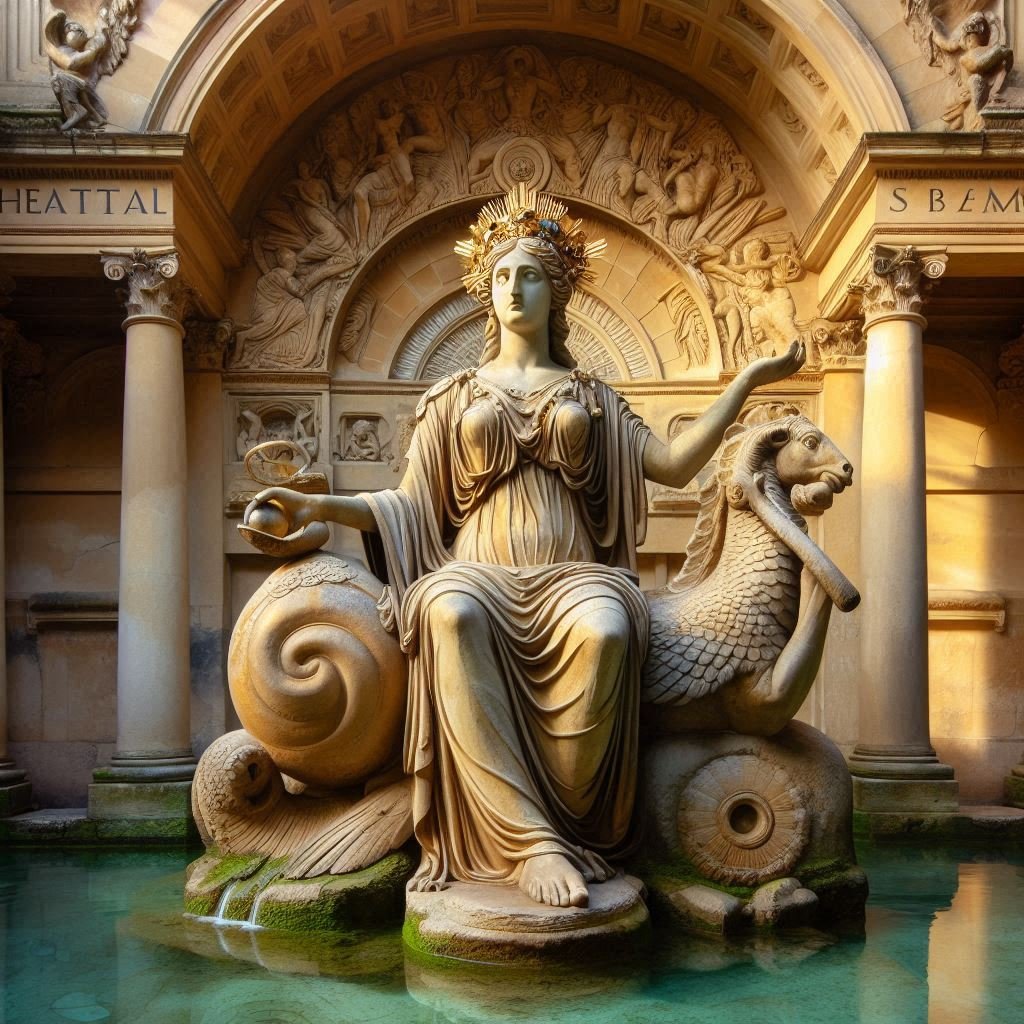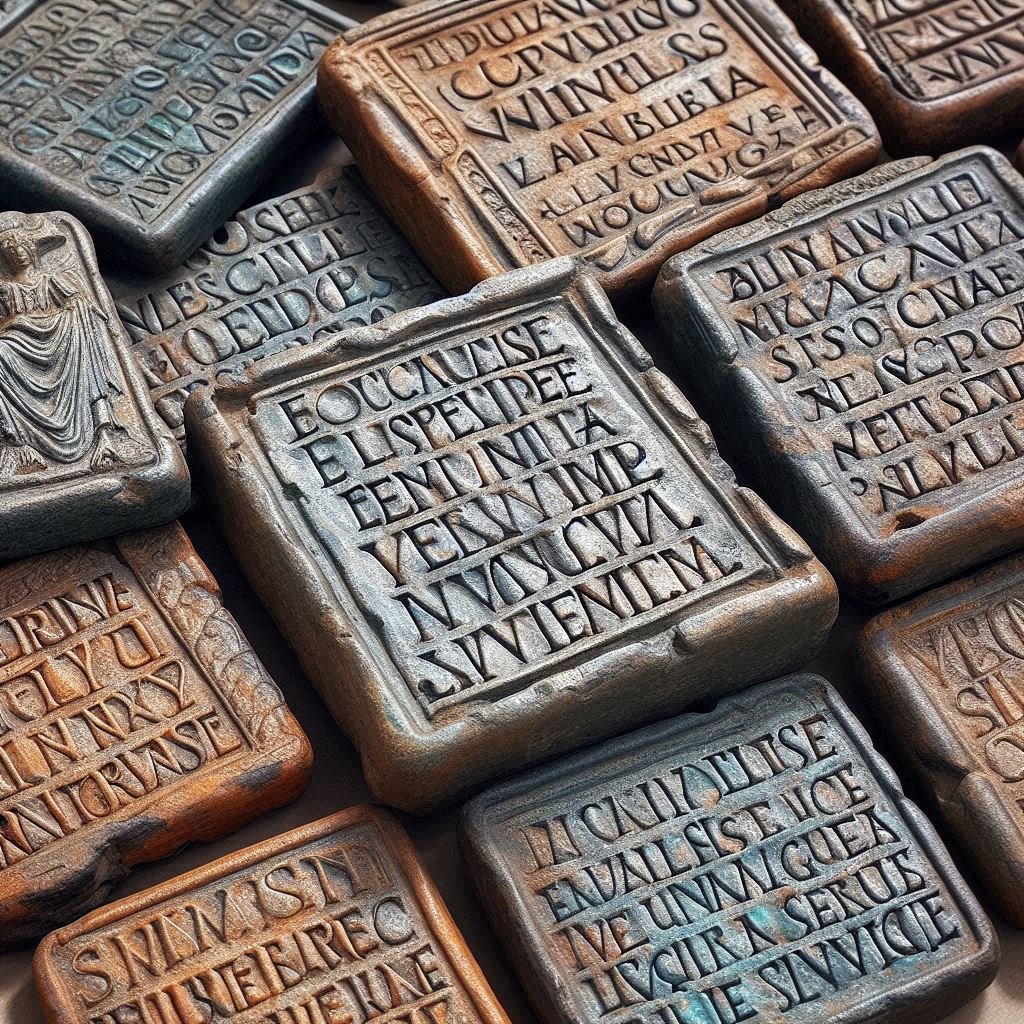
Sulis was a deity revered in the ancient Celtic religion as the goddess of the thermal springs in Bath, known to the Romans as Aquae Sulis, meaning “the waters of Sulis.” Her worship was likely rooted in the belief that these hot springs had healing properties, and she was venerated as a life-giving mother goddess as well as an agent of curses for those who sought her intervention. The etymology of her name is debated, but it may be related to the Proto-Celtic word for ‘sun,’ linking her to solar attributes.
The cult of Sulis was particularly prominent at the Roman temple in Bath, where numerous inscriptions and votive offerings have been discovered, suggesting a robust tradition of worship that included both public ceremonies and private devotions. The temple complex was a significant site of pilgrimage, drawing visitors who sought healing and solace in the sacred waters associated with Sulis. Her legacy continues to influence modern perceptions of the historical and spiritual significance of the Bath springs.

Sulis and Brigantia
Recently, I read some notes by Michael Shull, suggesting that there was good reason to consider Sulis and Brigantia to be the same core archetype.
The comparison between the goddess Sulis and Brigantia is a subject that intertwines history, mythology, and cultural syncretism. Sulis was a deity associated with healing, wisdom, and the life-giving properties of water. Her sanctuary was a place of pilgrimage, renowned for the curative powers of its waters, which were rich in minerals and naturally heated. The Romans equated Sulis with Minerva, their own goddess of wisdom, suggesting a complex interplay of attributes between these deities.
Brigantia, on the other hand, was a goddess revered by the Brigantes, an Iron Age Celtic tribe in what is now Northern England. She was associated with victory, power, and sovereignty, and her worship included the veneration of a perpetual flame, a symbol of enduring presence and sanctity. The Romans, in their cultural assimilation, linked Brigantia with their goddesses Victoria, Minerva, and Fortuna, indicating her multifaceted role within the pantheon.
The suggestion that Sulis and Brigantia may be aspects of the same entity arises from the overlapping characteristics they share, particularly with Minerva, and the geographical proximity of their primary places of worship. Both goddesses were integrated into the Roman pantheon through the process of interpretatio Romana, which often merged local deities with Roman ones, leading to a blending of attributes and stories.
Literature and historical records provide further insight into this connection. Notably, the Irish scholar Dáithí Ó hÓgáin proposed that the migration of the Brigantes tribe to southeastern Ireland could have introduced the goddess Brigantia to the region, eventually leading to her association with the Irish Brigid. This theory suggests a transference of divine identity across different cultures and regions, further complicating the narrative of these ancient deities.
The concept of a single divine entity manifesting in various forms is not unique to Sulis and Brigantia. Across different cultures and time periods, the idea of syncretism—where multiple gods and goddesses share attributes or are considered different expressions of the same divine force—is a common phenomenon. This is seen in the Hellenistic period, where Greek and Egyptian gods were combined, and in Hinduism, where deities like Vishnu have numerous avatars.
While Sulis and Brigantia are distinct in their origins and primary associations, the historical and cultural processes that have shaped their worship suggest a potential convergence of identities. The evidence from literature and archaeology points to a shared heritage that transcends individual narratives, reflecting the fluid and interconnected nature of ancient belief systems. The exploration of these goddesses sheds light on the past and offers a window into understanding the evolution of religious thought and the human inclination to seek common threads in the divine tapestry. Theories such as those proposed by Ó hÓgáin underscore the dynamic and ever-changing landscape of mythology, where gods and goddesses adapt and merge in response to the movements and interactions of the people who venerate them.
The Aquae Sulis sanctuary
The Aquae Sulis sanctuary, nestled in the heart of what is now modern-day Bath, England, was a remarkable testament to the confluence of indigenous Celtic traditions and Roman imperial culture. Established during the Flavian period, the sanctuary was initially an expression of Roman imperialism, symbolically asserting dominion over a revered indigenous sacred site. The central figure of worship at this sanctuary was Sulis Minerva, a syncretic deity that merged the local goddess Sulis with the Roman Minerva, embodying wisdom, healing, and the prophetic powers associated with the sacred springs.
The site itself was architecturally significant, featuring a temple precinct, a series of baths, and the hot spring that was the source of both its fame and its spiritual significance. The waters, believed to possess curative properties, drew visitors from across the Roman Empire, seeking remedies for various ailments. The spring was not only a place of physical healing but also a site of religious offerings and votive deposits, reflecting the deep spiritual connection the visitors felt with the divine presence of Sulis Minerva.
The sanctuary’s history is marked by its evolving relationship with the wider networks of the Roman Empire. While the initial emphasis on imperial domination waned, Aquae Sulis continued to be a place where individuals, particularly soldiers, could structure their identity and relationship to the emperor and the broader concepts of empire through the worship of Sulis Minerva. This is evidenced by the epigraphy linking the deity to the imperial cult found throughout the site.
The iconography of the sanctuary, especially the pediment of the temple adorned with the image of a Gorgon, is a subject of scholarly interest. It reflects the complex layering of cultural and religious identities that characterized the sanctuary. The Gorgon’s image, traditionally associated with protection and power, may have been intended to convey the protective nature of the goddess and the sanctuary itself.
The archaeological and epigraphic evidence from Aquae Sulis provides important information about the religious practices of the time. The votive offerings found in the sacred spring, ranging from coins to curse tablets, offer a glimpse into the hopes, fears, and daily lives of the people who visited the sanctuary. These artifacts suggest that the spring was not merely a place of healing but also a medium through which individuals communicated with the divine, seeking intervention in personal and legal matters.
The interpretation of the sanctuary has evolved, influenced by the biases and agendas of antiquarians and scholars. Recent studies have sought to re-evaluate the evidence and move away from entrenched views, aiming for a more holistic understanding of the sanctuary’s position and purpose within the broader socio-religious and cultural trends of the Roman period.
The Aquae Sulis sanctuary stands as a symbol of the dynamic interplay between local religious traditions and the overarching power of the Roman Empire. It serves as a reminder of the enduring human desire to connect with the divine, the healing power of nature, and the intricate ways in which cultural and religious practices can intertwine and evolve. The legacy of Aquae Sulis continues to captivate scholars and visitors alike, offering a window into the past and the timeless human pursuit of health, protection, and spiritual fulfilment. The sanctuary at Bath, with its rich history and archaeological significance, remains a poignant relic of a bygone era, echoing the ancient prayers and rituals that once permeated its sacred waters.
Architectural features of the Aquae Sulis sanctuary
The Aquae Sulis sanctuary, a jewel of Roman Britain, was renowned for its unique architectural features that blended the Roman engineering prowess with the sacredness of Celtic traditions. One of the most distinctive elements was the Great Bath, a massive pool fed by the sacred hot spring, which was open to the sky and surrounded by classical columns, creating a grandiose atmosphere for the bathers. The use of lead to line the pools and conduct the hot water was an engineering marvel of the time, showcasing the Romans’ advanced knowledge in creating a sophisticated water management system.
The temple of Sulis Minerva stood as a testament to religious syncretism, with a classical Roman facade and a Celtic deity enshrined within. The pediment of the temple featured a striking Gorgon’s head, which was likely meant to protect the sanctuary from evil spirits—a feature uncommon in Roman architecture but deeply rooted in local tradition. The presence of curse tablets, often inscribed with pleas for justice or revenge, thrown into the spring, further highlighted the blend of Roman and Celtic practices.
The sanctuary also boasted a complex system of hypocausts, an underfloor heating system that served the various baths, including the caldarium (hot bath), tepidarium (lukewarm bath), and frigidarium (cold bath). This technology provided a level of comfort and luxury that was unparalleled in Britain at the time. The intricate network of lead pipes that supplied water to the baths was a feat of Roman engineering, ensuring a constant flow of hot and cold water to meet the needs of the sanctuary’s visitors.
The layout of the sanctuary was meticulously planned to facilitate the flow of pilgrims and visitors. The design included a series of rooms and spaces that allowed for both public gatherings and private worship, reflecting the dual nature of the site as a place of communal healing and individual spiritual connection. The architectural design of Aquae Sulis was not only functional but also symbolic, with the placement of buildings and the use of space reflecting the religious significance of the site.
The remnants of the sanctuary’s architecture continue to captivate historians and archaeologists, providing insights into the daily lives and spiritual practices of those who visited this extraordinary site. The unique architectural features of Aquae Sulis stand as a testament to the ingenuity and adaptability of Roman construction, the reverence for local deities, and the enduring legacy of the Roman Empire in Britain. The sanctuary’s design and construction techniques have been studied extensively, offering a glimpse into the complexities of Roman provincial architecture and the ways in which it was influenced by local customs and beliefs. The Aquae Sulis sanctuary remains a symbol of the cultural and technological advancements of its time, and its architectural legacy continues to be a subject of fascination and study for those interested in the ancient world.
Curse tablets, also known as defixiones, were an integral part of the spiritual and judicial fabric of the Aquae Sulis sanctuary. These small, inscribed sheets of lead or pewter served as a direct line of communication between the worshippers and the goddess Sulis Minerva, to whom the sanctuary was dedicated. The primary purpose of these tablets was to invoke the deity’s intervention in matters of personal injustice, particularly the theft of personal property. Individuals who suffered from theft would inscribe their grievances and the names of suspected thieves on these tablets, calling upon Sulis Minerva’s divine justice to identify and punish the wrongdoers.
The act of creating a curse tablet was both a religious ritual and a form of magical practice. The inscriptions often followed a formulaic structure, with the petitioner outlining the stolen items and requesting the goddess to inflict various misfortunes upon the thief until the stolen goods were returned. This practice reflects the belief in the goddess’s omniscience and her ability to enforce moral order. The tablets were then deposited into the sacred spring, believed to be a portal to the deity, ensuring that the messages reached Sulis Minerva directly.
The use of curse tablets was not unique to Aquae Sulis; it was a widespread phenomenon throughout the Roman Empire. However, the large number of tablets found at this site, approximately 130, underscores the significance of Sulis Minerva in the daily lives of the local population and the trust placed in her powers. The tablets provide valuable insights into the legal and social concerns of the time, as well as the linguistic diversity, with inscriptions in various dialects and levels of literacy.
The content of the curse tablets from Aquae Sulis also reveals the types of crimes that were prevalent and the nature of the community’s response to such offences. They serve as historical documents that offer a glimpse into the lives of ordinary people, their beliefs, and their recourse to divine justice in the absence of effective worldly legal mechanisms. The tablets are a testament to the enduring human desire for fairness and retribution, and the belief in the supernatural to achieve it.

These are AI-generated and only give a feel for what curse tablets might have originally looked like
Curse Tablets
The curse tablets at Aquae Sulis were more than mere written pleas; they were part of a complex ritual that combined elements of magic and religion. The creation of a curse tablet began with the drafting of the text, which was often done by a scribe due to the illiteracy of the petitioner. The text would detail the wrong that had been done, often theft, and call upon the goddess Sulis Minerva to bring justice. The ritual continued with the tablet being folded or rolled, sometimes pierced with nails, to activate the curse. The act of depositing these tablets into the sacred spring was significant; it was believed that this would carry the messages directly to the goddess in her watery domain.
The spring itself was considered a liminal space, a portal to the divine, where the mundane world could interact with the supernatural. By submerging the tablets in the waters, the supplicants were engaging in a direct dialogue with Sulis Minerva, entrusting her with their grievances and seeking her powerful intervention. Some theories suggest that before being cast into the spring, the tablets may have been publicly displayed or their curses recited aloud to enact the spells contained within them. This public aspect of the ritual would have served to warn others of the consequences of wrongdoing and the reach of divine justice.
The relationship between the supplicant and the deity was viewed as a contract; in exchange for the goddess’s intervention, the petitioner would often promise an offering or sacrifice, sometimes the very item that had been stolen if it were to be returned. This reciprocal arrangement was a key feature of the ritual, emphasizing the give-and-take nature of Roman religious practices.
The ritual use of curse tablets at Aquae Sulis reflects the broader practices of the Roman world, where personal justice and divine retribution were sought through similar means. However, the unique setting of the sanctuary, with its healing waters and the presence of a powerful goddess, gave these rituals a particular local significance. The tablets from Aquae Sulis provide a rich source of information about the beliefs, hopes, and fears of those who lived and worshipped there, offering a vivid picture of the intersection between human desires and divine will in the ancient world.
The historical record regarding the fulfilment or lifting of curses at Aquae Sulis is not explicit, as the nature of curse tablets and their outcomes were not typically documented in a manner that would survive the passage of time. However, the very act of creating and depositing a curse tablet in the sacred spring was believed to invoke the goddess Sulis Minerva’s power to address the grievances inscribed upon them. The faith placed in these rituals by the individuals who created the tablets suggests that they believed in the efficacy of their actions and the divine intervention of the goddess.
While there are no specific historical accounts of curses being lifted or fulfilled, the continued practice of creating and depositing these tablets indicates that the people of the time must have believed in their effectiveness. The tablets often included promises of offerings to the goddess in exchange for her intervention, implying a transactional relationship where the fulfilment of the curse would be reciprocated by the petitioner’s gratitude and sacrifice.
It is also possible that the public aspect of some curse rituals, where the curses might have been recited aloud before being deposited, served as a social deterrent against theft and other wrongdoings, thereby fulfilling the purpose of the curse indirectly by preventing further offences. The psychological impact of being publicly cursed or knowing that one could be cursed for committing a crime could have been a powerful tool in maintaining social order.
One notable example of a curse tablet stands out for its detailed curse, which is both specific and illustrative of the types of grievances brought before the goddess Sulis Minerva. This particular tablet invokes the goddess to make the thief who stole Vilbia become as liquid as water, and for the person who consumed Vilbia obscenely to become mute.
These curse tablets, often inscribed with meticulous detail, were not just simple messages; they were crafted with the intent to communicate directly with the divine, to seek justice and retribution for wrongs that had no other form of redress. The specificity of the curses, the personal nature of the grievances, and the invocation of the goddess’s power all reflect the deep-seated belief in the supernatural and the reliance on the deities for intervention in daily life.
The discovery of these tablets was a watershed moment in the understanding of Roman Britain and the practices associated with curse-making. The tablets were meticulously analysed by historians, revealing the common practice of cursing those who committed petty thefts, a testament to the social and legal issues of the era. The curses were addressed to Sulis Minerva, who was believed to possess the power to enforce justice, a belief that underscores the importance of the goddess in the local community.
The craftsmanship of the tablets varied, with some being smoothly finished while others appeared to be hastily constructed. This variation suggests a range of social statuses among the petitioners, indicating that the practice of curse-making was not limited to a particular class but was a widespread means of seeking justice. The tablets were often inscribed with a stylus, and the act of writing the curse was in itself a ritualistic process, imbued with magical significance.
The content of the tablets is diverse, with some focusing on the theft of clothing or the betrayal by a lover, while others are more general, cursing any who might have stolen from the petitioner. The curses could be quite creative, calling for the thieves to lose their minds, be struck down by illness, or suffer financial ruin until the stolen items were returned. This creativity in cursing reflects the personal investment of the individuals in the ritual and their desire for a tangible resolution to their problems.
Other inscriptions found at Aquae Sulis
The architectural inscriptions, which detail the construction and dedication of buildings within the sanctuary, are particularly valuable for understanding the development of the site over time. These inscriptions often include the names of architects, patrons, and officials, shedding light on the individuals responsible for the sanctuary’s physical landscape.
The inscriptions at Aquae Sulis also include honorific texts, which celebrated the achievements and status of prominent citizens and officials. These texts would have been prominently displayed to reinforce social hierarchies and the prestige of the individuals they commemorated.
The architectural inscriptions at Aquae Sulis are a source of historical knowledge, providing insight into the construction, dedication, and use of the structures within this ancient Roman sanctuary. These inscriptions, often carved on stone or metal, served various purposes, from commemorating the completion of buildings to honouring the deities worshipped within them. The inscriptions found at Aquae Sulis are particularly valuable for understanding the Roman approach to integrating their culture with the existing Celtic traditions.
One of the most significant aspects of these inscriptions is their role in documenting the development of the site. They often include the names of architects, patrons, and officials responsible for the construction and maintenance of the sanctuary’s buildings. This not only helps historians piece together the timeline of the sanctuary’s expansion but also sheds light on the individuals who played key roles in its history.
The inscriptions also reveal the religious significance of the structures at Aquae Sulis. Dedications to Sulis Minerva, the syncretic deity of the sanctuary, are common, reflecting the deep reverence for the goddess and the importance of the healing waters she presided over. These dedications could be found on altars, temple facades, and even the tools and implements used in the construction of the sanctuary, indicating a pervasive sense of piety and the infusion of the sacred into every aspect of the site.
Moreover, the architectural inscriptions provide evidence of the multicultural nature of Aquae Sulis. The names and titles inscribed on the stones reflect a diverse range of linguistic and ethnic backgrounds, showcasing the sanctuary as a melting pot of cultures within the Roman Empire. This diversity is indicative of the extensive reach of the empire and its impact on the societies it encompassed.
The inscriptions also served a commemorative function, celebrating the achievements and status of prominent citizens and officials. These honorific texts would have been prominently displayed to reinforce social hierarchies and the prestige of the individuals they commemorated. Such inscriptions were not merely informative but were also intended to convey messages about power, status, and the social order of the time.
In addition to formal dedications and honorifics, the architectural inscriptions at Aquae Sulis included more personal and informal texts, such as graffiti. These scribbles on the walls of the baths or the temple precinct provide a candid look into the thoughts and daily activities of the ordinary people who visited the sanctuary. From declarations of love to simple markings of presence, these inscriptions add a human touch to the archaeological record.
The inscriptions at Aquae Sulis are a testament to the complex and vibrant society that existed around the sanctuary. They document the religious, social, military, and political aspects of life in Roman Britain and provide invaluable insights into the interactions between the Roman conquerors and the local Celtic population. The variety of inscriptions reflects the multifaceted nature of the site as a place of healing, worship, and social convergence, making Aquae Sulis a focal point for the study of Roman provincial life.
Subscribe to our post updates - Don't miss a thing!!








